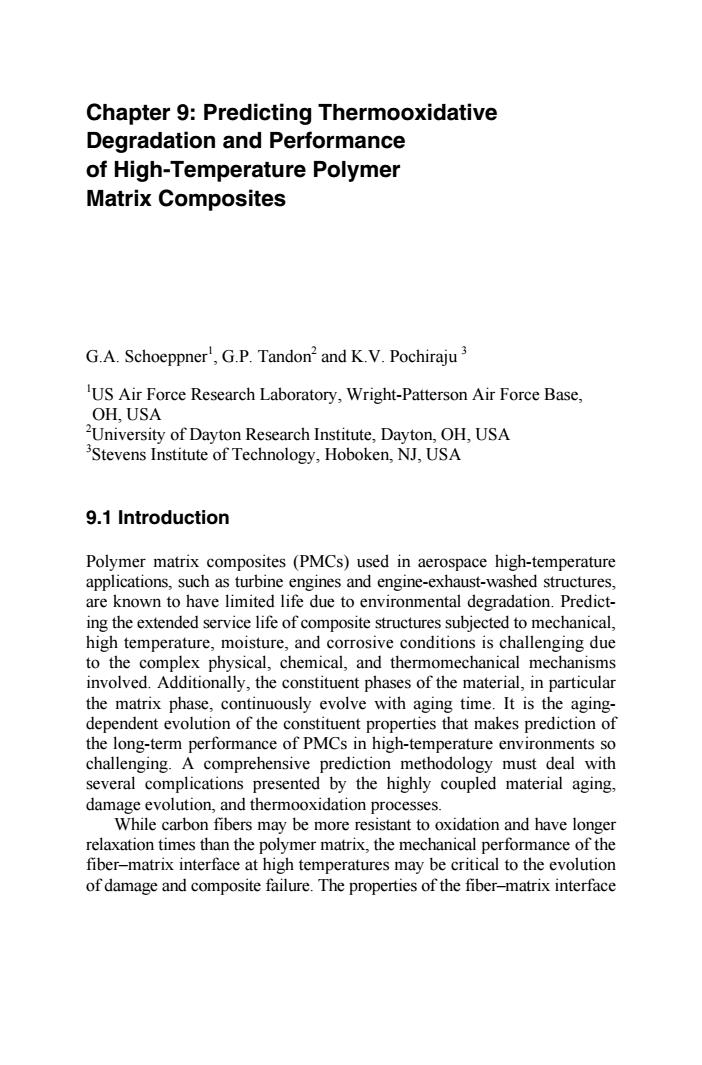正在加载图片...

Chapter 9:Predicting Thermooxidative Degradation and Performance of High-Temperature Polymer Matrix Composites G.A.Schoeppner',G.P.Tandon2and K.V.Pochiraju3 US Air Force Research Laboratory,Wright-Patterson Air Force Base, OH.USA 2University of Dayton Research Institute,Dayton,OH,USA Stevens Institute of Technology,Hoboken,NJ,USA 9.1 Introduction Polymer matrix composites (PMCs)used in aerospace high-temperature applications,such as turbine engines and engine-exhaust-washed structures, are known to have limited life due to environmental degradation.Predict- ing the extended service life of composite structures subjected to mechanical, high temperature,moisture,and corrosive conditions is challenging due to the complex physical,chemical,and thermomechanical mechanisms involved.Additionally,the constituent phases of the material,in particular the matrix phase,continuously evolve with aging time.It is the aging- dependent evolution of the constituent properties that makes prediction of the long-term performance of PMCs in high-temperature environments so challenging.A comprehensive prediction methodology must deal with several complications presented by the highly coupled material aging, damage evolution,and thermooxidation processes. While carbon fibers may be more resistant to oxidation and have longer relaxation times than the polymer matrix,the mechanical performance of the fiber-matrix interface at high temperatures may be critical to the evolution of damage and composite failure.The properties of the fiber-matrix interfaceChapter 9: Predicting Thermooxidative Degradation and Performance 1 2 3 1 US Air Force Research Laboratory, Wright-Patterson Air Force Base, OH, USA 2 University of Dayton Research Institute, Dayton, OH, USA 3 Stevens Institute of Technology, Hoboken, NJ, USA 9.1 Introduction Polymer matrix composites (PMCs) used in aerospace high-temperature applications, such as turbine engines and engine-exhaust-washed structures, are known to have limited life due to environmental degradation. Predicting the extended service life of composite structures subjected to mechanical, high temperature, moisture, and corrosive conditions is challenging due to the complex physical, chemical, and thermomechanical mechanisms involved. Additionally, the constituent phases of the material, in particular the matrix phase, continuously evolve with aging time. It is the agingdependent evolution of the constituent properties that makes prediction of the long-term performance of PMCs in high-temperature environments so challenging. A comprehensive prediction methodology must deal with several complications presented by the highly coupled material aging, damage evolution, and thermooxidation processes. While carbon fibers may be more resistant to oxidation and have longer relaxation times than the polymer matrix, the mechanical performance of the fiber–matrix interface at high temperatures may be critical to the evolution of damage and composite failure. The properties of the fiber–matrix interface of High-Temperature Polymer Matrix Composites G.A. Schoeppner , G.P. Tandon and K.V. Pochiraju